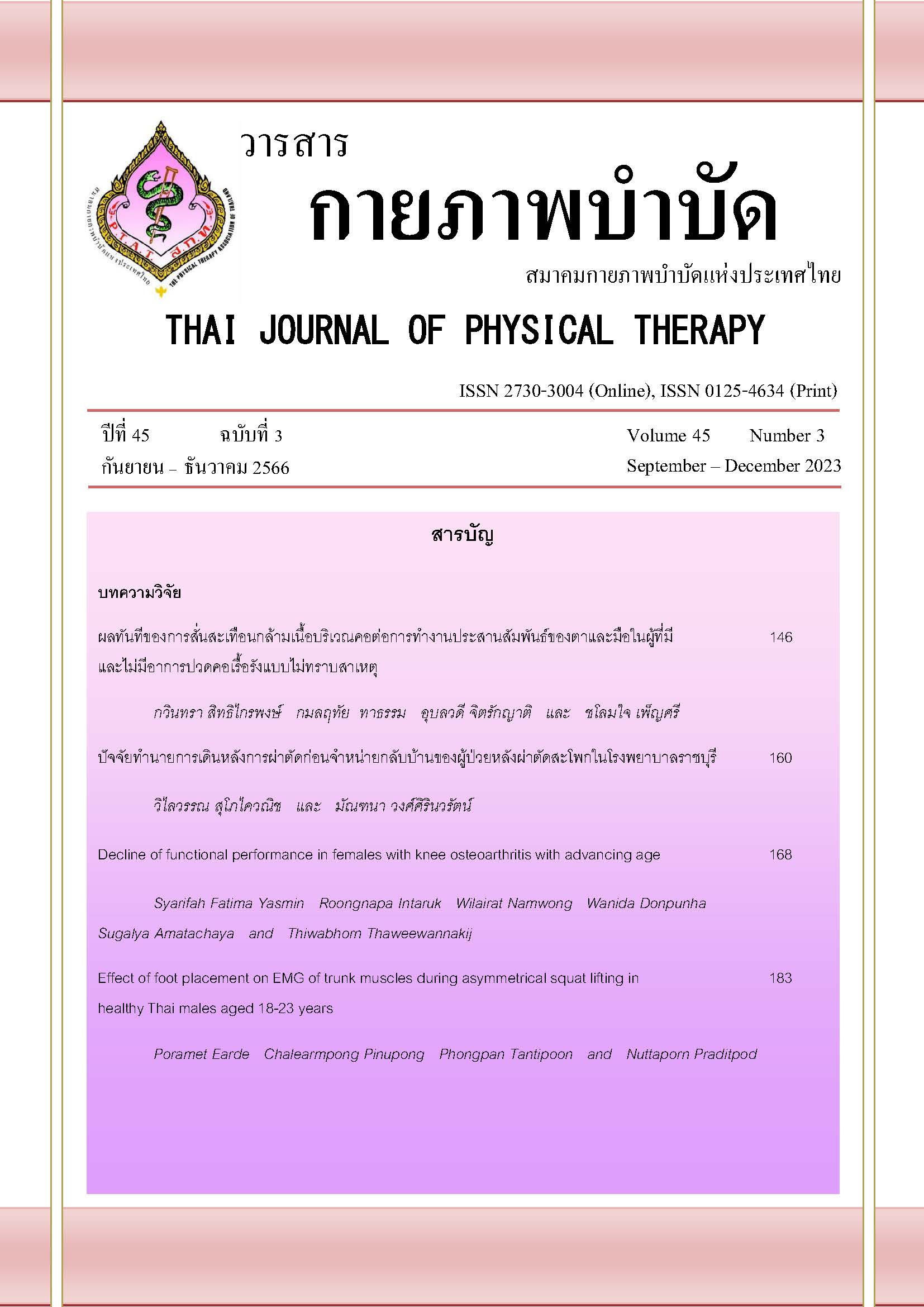ปัจจัยทำนายการเดินหลังการผ่าตัดก่อนจำหน่ายกลับบ้านของผู้ป่วยหลังผ่าตัดสะโพกในโรงพยาบาลราชบุรี
Main Article Content
บทคัดย่อ
ที่มาและความสำคัญ: กระดูกสะโพกหักเป็นภาวะการบาดเจ็บรุนแรงที่พบได้บ่อยในกลุ่มผู้สูงอายุ ภาวะนี้อาจนำไปสู่ความทุพพลภาพได้มาก โดยเฉพาะการกลับไปยืนเดินได้ในชีวิตประจำวัน ผู้ป่วยหลังผ่าตัดสะโพกควรต้องได้รับโปรแกรมกายภาพบำบัดเพื่อการฟื้นฟูการเคลื่อนไหว และลดภาวะแทรกซ้อน การระบุปัจจัยที่มีผลต่อการกลับมาเดินได้เองของผู้ป่วยก่อนกลับบ้านจึงมีความสำคัญในการวางแผนการให้บริบาลฟื้นสภาพระยะกลาง
วัตถุประสงค์: เพื่อศึกษาอำนาจการทำนายร่วมของตัวแปรที่สำคัญจากการทบทวนวรรณกรรม 5 ปัจจัย ได้แก่ อายุ ตำแหน่งสะโพกที่หัก ระยะเวลาที่ได้รับการผ่าตัดหลังกระดูกหัก การได้รับโปรแกรมทางกายภาพบำบัดก่อนผ่าตัด และระยะเวลาเริ่มทำกายภาพบำบัดหลังผ่าตัด ที่มีผลต่อการเดินได้เองก่อนจำหน่ายผู้ป่วยกลับบ้าน
วิธีการวิจัย: สืบค้นข้อมูลย้อนหลังจากเวชระเบียนของผู้ป่วยที่ได้รับการผ่าตัดสะโพกที่โรงพยาบาลราชบุรีที่อายุมากกว่า 60 ปี จำนวน 78 คน นำมาวิเคราะห์ข้อมูลด้วยสถิติพรรณนาและสถิติแบบถดถอยโลจิสติกส์
ผลการวิจัย: ผู้ป่วยที่มีการหักบริเวณต้นขาส่วนคอ (femoral - neck fracture) มีโอกาสเดินได้หลังผ่าตัดมากกว่า 7.1 เท่า เมื่อเทียบกับการหักบริเวณต้นขาผ่านแนวปุ่มกระดูก (intertrochanteric fracture) อย่างมีนัยสำคัญทางสถิติ (p=0.001) ส่วนปัจจัยอื่นไม่สามารถทำนายการเดินได้เองก่อนจำหน่ายกลับบ้าน
สรุปผล: ตำแหน่งสะโพกที่หักสามารถทำนายการเดินหลังการผ่าตัดก่อนจำหน่ายกลับบ้านได้ ผู้ป่วยที่มีการหักบริเวณต้นขาผ่านแนวปุ่มกระดูกมีโอกาสจะเดินไม่ได้มากกว่า นักกายภาพบำบัดควรให้ความสนใจเป็นพิเศษในการให้โปรแกรมฟื้นฟูในกลุ่มผู้สูงอายุที่มีสะโพกหักบริเวณนี้ ผลการศึกษานี้มีความสำคัญต่อแนวทางในการพัฒนาโปรแกรมการดูแลฟื้นฟูของผู้ป่วยผ่าตัดสะโพก
Article Details

อนุญาตภายใต้เงื่อนไข Creative Commons Attribution-NonCommercial-NoDerivatives 4.0 International License.
เอกสารอ้างอิง
Roche JJ, Wenn RT, Sahota O, Moran CG. Effect of comorbidities and postoperative complications on mortality after hip fracture in elderly people: prospective observational cohort study. BMJ. 2005;331(7529):1374.
Sucharitpongpan W, Daraphongsataporn N, Saloa S, Philawuth N, Chonyuen P, Sriruanthong K, et al. Epidemiology of fragility hip fractures in Nan, Thailand. Osteoporos Sarcopenia. 2019;5(1):19-22.
Ortiz-Alonso FJ, Vidan-Astiz M, Alonso-Armesto M, Toledano-Iglesias M, Alvarez-Nebreda L, Branas-Baztan F, et al. The pattern of recovery of ambulation after hip fracture differs with age in elderly patients. J Gerontol A Biol Sci Med Sci. 2012;67(6):690-7.
Klestil T, Roder C, Stotter C, Winkler B, Nehrer S, Lutz M, et al. Sci Rep. 2018;8(1):13933.
McGregor AH, Rylands H, Owen A, Dore CJ, Hughes SP. Does preoperative hip rehabilitation advice improve recovery and patient satisfaction? J Arthroplasty. 2004;19(4):464-8.
Lei YT, Xie JW, Huang Q, Huang W, Pei FX. Benefits of early ambulation within 24 h after total knee arthroplasty: a multicenter retrospective cohort study in China. Mil Med Res. 2021;8(1):17.
Dubljanin-Raspopovic E, Markovic-Denic L, Marinkovic J, Grajic M, Tomanovic Vujadinovic S, Bumbasirevic M. Use of early indicators in rehabilitation process to predict one-year mortality in elderly hip fracture patients. Hip Int. 2012;22(6):661-7.
Kristensen MT. Factors affecting functional prognosis of patients with hip fracture. Eur J Phys Rehabil Med. 2011;47(2):257-64.
Folden S, Tappen R. Factors influencing function and recovery following hip repair surgery. Orthop Nurs. 2007;26(4):234-41.
Kim JL, Jung JS, Kim SJ. Prediction of ambulatory status after hip fracture surgery in patients over 60 years old. Ann Rehabil Med. 2016;40(4):666-74.
หน่วยงานห้องผ่าตัด โรงพยาบาลราชบุรี. (2563-2564). สถิติจำนวนการผ่าตัดสะโพก:หน่วยงานห้องผ่าตัดโรงพยาบาลราชบุรี จังหวัดราชบุรี
Svensson O, Stromberg L, Ohlen G, Lindgren U. Prediction of the outcome after hip fracture in elderly patients. J Bone Joint Surg Br. 1996;78(1):115-8.
Green SB. How many subjects does it take to do a regression analysis. Multivariate Behav Res. 1991;26(3):499-510.
Kristensen MT, Bandholm T, Bencke J, Ekdahl C, Kehlet H. Knee-extension strength, postural control and function are related to fracture type and thigh edema in patients with hip fracture. Clin Biomech (Bristol, Avon). 2009;24(2):218-24.
Haentjens P, Autier P, Barette M, Venken K, Vanderschueren D, Boonen S, et al. Survival and functional outcome according to hip fracture type: a one-year prospective cohort study in elderly women with an intertrochanteric or femoral neck fracture. Bone. 2007;41(6):958-64.
Lu Y, Uppal HS. Hip Fractures: Relevant Anatomy, Classification, and Biomechanics of Fracture and Fixation. Geriatr Orthop Surg Rehabil. 2019;10:2151459319859139.
Clemmesen CG, Tavenier J, Andersen O, Palm H, Foss NB. Methylprednisolone and inflammatory stress response in older people undergoing surgery for hip fracture: a secondary analysis of a randomized controlled trial. Eur Geriatr Med. 2019;10(6):913-21.


